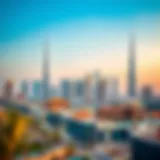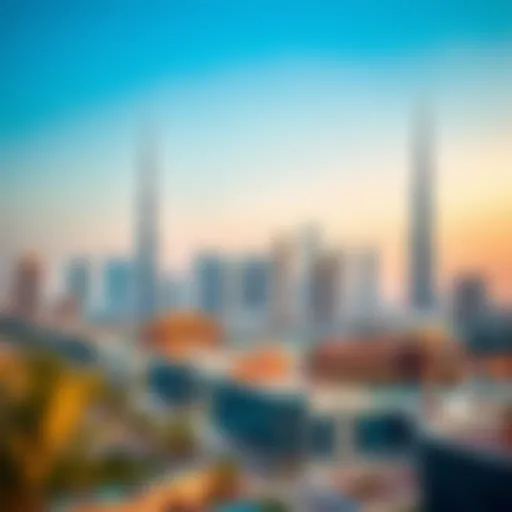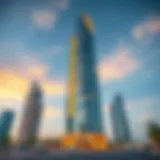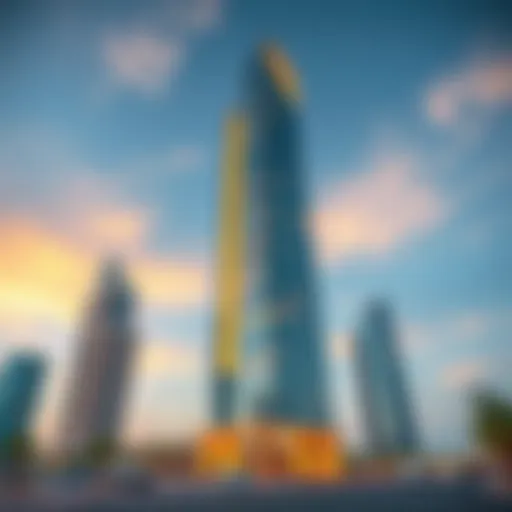Dubai Metro: Transforming Urban Transport in the City


Intro
Navigating a modern metropolis like Dubai requires a dependable and efficient transport system. The Dubai Metro, as a cornerstone of urban transit, has morphed the city's commuting landscape since its inception. With 74 kilometers of track and numerous stations, it connects the bustling areas of Dubai seamlessly and has become a lifeline for both residents and visitors.
Rather than just being a means to get from point A to B, the metro represents a noteworthy case study in how infrastructural developments can interlace with urban planning and economic growth. This article offers a comprehensive guide to understanding the multi-layered functions and implications of the metro system, from its historical roots to its far-reaching impacts on real estate and sustainability.
As we dissect the structure and efficiency of the metro, we will see how it has not only shaped commuting dynamics but also acted as a catalyst for the property market. In addition, future prospects regarding potential expansions and enhancements in the name of sustainable transport will be explored. Through this narrative, we aim to equip investors, buyers, and analysts with a nuanced understanding of the intricate relationship between the metro and Dubai's evolving urban landscape.
Foreword to Dubai Metro
The Dubai Metro stands as a testament to the rapid growth and modernization of urban transport systems in the 21st century. It represents not only a vital infrastructure project but also the ambitions of a city that aims to redefine urban commuting. For investors, buyers, agents, designers, and analysts, understanding the nuances of the Dubai Metro is crucial, as it influences broader economic dynamics and property trends in the region.
As cities grow densier, efficient transport systems become indispensable. The significance of the Dubai Metro is multi-faceted; it’s about connecting people, improving accessibility, and enhancing urban living. This section will examine the historical backdrop that paved the way for the metro system, along with its purpose and overarching vision.
Historical Context
The conception of the Dubai Metro originated in the early 2000s, a period where the emirate was experiencing an explosive influx of residents. The population boom, fueled by economic diversification and globalization, created an urgent need for a reliable transport system. In 2005, the Dubai Government made the bold decision to invest in a metro system, with construction commencing soon after.
Interestingly, the project broke ground in 2006 with a vision to integrate multiple transport options and thus, alleviate traffic congestion. The first phase of the metro opened in 2009, focusing on the Red Line, which stretches over 52 kilometers. The rapid advancement of this infrastructure project, amid a backdrop of ambitious urban development, showcases the forward-thinking nature of government planners and urban strategists in Dubai.
Today, the metro is a crucial artery of the city, linking major commercial and residential areas, proving that even in an arid desert, essential connectivity can flourish.
Purpose and Vision
The primary purpose behind the Dubai Metro was to create a sustainable and efficient public transit system that encourages the use of public transport rather than personal vehicles. This vision aligns with global trends toward sustainability and reduced carbon footprints, especially in urban environments plagued by traffic congestion and pollution.
Key aspects of this vision are:
- Reduction of Traffic: By providing an alternate mode of transport, the metro aims to alleviate road congestion, which has a ripple effect on traffic patterns across the city.
- Environmental Sustainability: With a goal to decrease carbon emissions, the metro's establishment supports is essential to the broader vision of a greener city.
- Economic Growth: Easy access to transport is known to raise property values and encourage investments in nearby areas. The metro is a vital piece in the economic growth puzzle of Dubai.
Moreover, the government envisions expanding the system further, adding lines and stations, fostering urban development along these corridors.
In summary, the introduction of the Dubai Metro is not merely about transportation; it's about rethinking urban mobility, creating opportunities, and preparing for a future that intertwines efficiency and sustainability. Its historical roots and strategic vision set the stage for a transformative impact on the metropolis.
Design and Structure
The design and structure of the Dubai Metro are critical in setting it apart as a benchmark in the field of urban transit systems. As the city continues to grow and diversify, understanding how these elements come together offers insights not only into the metro's operational efficiency but also into its broader implications for urban planning and real estate markets.
The Rail Network
The rail network of the Dubai Metro is akin to a well-tuned orchestra, where each line, station, and connection plays its unique part. Serving over 1.5 million riders daily, the metro has been meticulously planned to cover vast swathes of the city, connecting key commercial, residential, and recreational areas.
The two primary lines, the Red and Green, stretch a total of around 75 kilometers, boasting 49 stations in total. Each station serves as a critical node in the overall network, allowing seamless transfers and increasing overall accessibility. The advancements in technology employed in this system eliminate many operational hiccups, resulting in high frequencies of service. Surprisingly, the metro operates without drivers, relying instead on cutting-edge automatic control systems, a decision that underscores Dubai's commitment to pioneering innovation in public transport.
The elevated and underground sections of the metro also reflect design ingenuity. Built to conserve space in a densely populated city, the elevated tracks add a futuristic aesthetic to the skyline, while underground segments are constructed with minimal disruption to the urban fabric above. This dual approach serves not just practicality but also enhances the overall commuter experience.
Station Layouts and Features
The station layouts and features of the Dubai Metro are designed with ergonomics and efficiency in mind. Each station presents a unique aesthetic, often adorned with art and cultural motifs that resonate with the rich heritage of the UAE. This aspect contributes to an immersive travel experience, attracting both locals and tourists alike.
Stations are typically spacious and well-lit, promoting safety and comfort for passengers. Features like kiosks, waiting areas, and digital information displays cater to the needs of riders, ensuring that information is readily available at their fingertips. Moreover, the integration of escalators and lifts makes the metro accessible, thereby embracing inclusivity in a multifaceted society.
Key stations, such as the Burj Khalifa/Dubai Mall station, embody meticulous planning by being situated in proximity to significant landmarks and attractions. As a result, it not only functions as a transit point but also as a hub for commerce and tourism, enhancing local business vibrancy.
The metro stations are also equipped with advanced security systems, including CCTV and a visible police presence, enhancing safety measures to encourage further usage. It's this blend of design, functionality, and attention to detail that solidifies the Dubai Metro as a model for urban transport systems around the globe.
"The Dubai Metro is not merely a transit system; it is a symbol of modern urban planning and technological advancement in the heart of a dynamic city like Dubai."
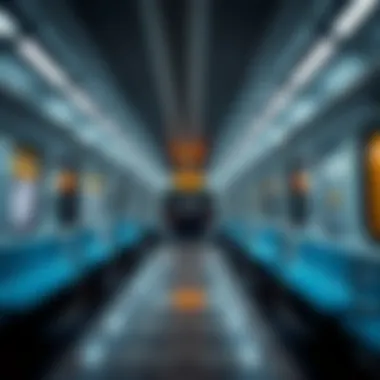

In summary, the design and structure of the Dubai Metro is carefully orchestrated to promote efficiency, accessibility, and aesthetic appeal. These qualities contribute to a transport experience that is both practical and enjoyable for users, laying down a road map for future developments in the city's transit landscape.
Operational Efficiency
The operational efficiency of the Dubai Metro is a critical aspect that contributes significantly to its overall success and effectiveness as a mode of urban transport. Understanding this efficiency not only sheds light on how well the system caters to the needs of commuters but also highlights the intricate balance required to manage such an expansive public transit network.
A well-functioning metro system significantly reduces the strain on urban infrastructure. With the growing population in Dubai, it is paramount that its public transport be efficient and reliable. This efficiency is primarily reflected in two key areas: service frequencies and ticketing and pricing structures. Let us explore both.
Service Frequencies
The frequency of services available in the Dubai Metro is remarkably efficient. Trains run at intervals as short as every two to three minutes during peak hours. This ensures that commuters do not face long waiting times, promoting higher ridership. High service frequency minimizes the chances of overcrowding, making for a more pleasant travel experience.
- During peak hours, the availability of trains facilitates quick movement across the city.
- It allows for a reliable schedule, enabling passengers to plan their trips with certainty.
Such operational standards exemplify how a well-coordinated inter-modal transport system can alleviate traffic congestion and improve overall urban mobility. In comparison to other cities with metro systems, Dubai's commitment to high-frequency service sets a benchmark that underscores the importance of operational efficiency in public transit.
Ticketing and Pricing Structure
Pricing of metro tickets is strategically crafted to encourage usage while sustaining economic viability for the operators. The ticketing system is user-friendly and allows passengers to choose from various options, including single rides, day passes, and monthly subscriptions.
- The NOL Card system enables seamless travel by eliminating the need for cash or physical tickets. Instead, riders can simply tap their card on entry and exit gates, leading to a smooth commuting experience.
- Pricing varies based on the distance traveled, making it economical for short trips as well as longer journeys.
This dynamic pricing strategy not only incentivizes usage but also ensures that the metro remains accessible for a wide demographic, from tourists to everyday commuters.
It’s evident that well thought-out operational strategies like service frequency and ticketing are essential for the success of the Dubai Metro.
Impact on Urban Mobility
The Dubai Metro not only serves as a means of transport but also as a catalyst for reshaping the urban landscape of Dubai. With a rapidly growing population and an ever-increasing influx of visitors, the importance of efficient urban mobility has never been greater. The Metro enhances access to essential amenities and significantly reduces traffic congestion. As a result, it fosters economic development, improves air quality, and promotes a more sustainable lifestyle through reduced vehicle emissions.
Reduction of Traffic Congestion
One of the standout benefits of the Dubai Metro is its ability to mitigate traffic congestion. The city, often described as a concrete jungle, faces issues typical of urban sprawl. Before the Metro came into play, the roads were choked with vehicles, leading to frustrating delays for commuters. By offering a reliable alternative, the Metro has eased the burden on the road network, allowing cars to breathe once again.
For instance, during peak hours, the Metro carries over 600,000 passengers daily, taking many off the roads. This not only leads to less time wasted in traffic but also opens up pathways for emergency services and public transport vehicles to maneuver more freely.
"A well-connected community is a thriving community. Reduced congestion leads to a higher quality of life for all residents."
The reduction in congestion translates into lower fuel consumption and less wear and tear on vehicles, resulting in cost savings for residents. In many respects, Dubai Metro has turned a complex puzzle of urban transportation into a more cohesive picture, boosting connectivity across the city.
Accessibility and Inclusivity
Accessibility is a core tenet of the Metro's design principles. The Dubai Metro aims not only to be a mode of transport but also to be inclusive. With dedicated facilities for the differently-abled, such as ramps, tactile guidance paths, and elevators, the Metro ensures that all members of the community can access transit services.
Moreover, the stations are strategically located near residential areas, shopping malls, and business districts, making it easier for different demographics to utilize public transport. This convenience is crucial in supporting less affluent areas and ensuring that all residents, regardless of income level, have access to high-quality transit options.
The Metro also extends its influence on social equity. The use of affordable ticketing options, coupled with free rides for schoolchildren and senior citizens, exemplifies a commitment to inclusivity. Such measures foster a sense of community, making public transportation accessible, which in turn encourages its use.
In turn, this shift towards a more inclusive transport method cultivates a more integrated society, where diverse groups can come together in shared spaces, reducing social barriers that may otherwise exist.
As the Dubai Metro continues to develop, the emphasis placed on accessibility and inclusivity paves the way for a transportation model that not only serves its immediate purpose but also enriches the fabric of the community it aims to serve.
For further reading on urban mobility and transportation planning, resources like Wikipedia, Britannica, and various academic journals focused on public transit can offer more in-depth perspectives.
Integration with the Real Estate Market
The intricate relationship between the Dubai Metro and the real estate market transcends mere convenience for commuters; it's a fundamental aspect that shapes the urban landscape of the city. This connection becomes particularly relevant for investors, buyers, and agents, as the dynamics of property values and development heavily lean on the accessibility provided by the metro system. The metro is more than just a mode of transport; it serves as a catalyst for growth, igniting interest in areas that were previously overlooked.
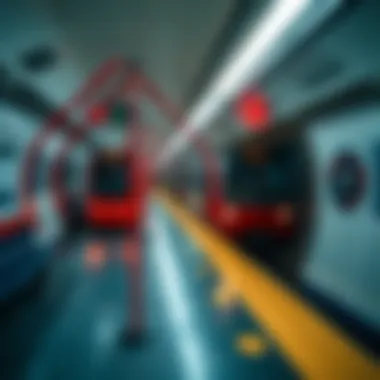

Influence on Property Values
The impact of the Dubai Metro on property values can hardly be overstated. As easy access to efficient transport is often synonymous with higher property demand, areas close to metro stations are likely experiencing an uptick in their livability quotient. Investors have their eyes peeled on these zones, striking while the iron is hot. Data analysis shows that property prices within close proximity to metro stations generally see a price premium of up to 20% compared to similar properties situated further away.
- Increased Demand: As people start to flock towards more accessible locations, demand follows. The result is a climb in property values in those areas.
- Initial Investment Boost: New developments around metro stations typically attract initial investments due to the expectation of higher returns over time.
- Diversified Portfolio Options: For buyers, proximity to a metro station can also mean diverse options, including apartments or commercial spaces, catering to both residential and business needs.
“In essence, properties near Dubai Metro stations are not just homes or offices; they signify a wise investment, offering proximity to one of the most efficient public transport systems.”
Developments Along Metro Lines
Alongside the direct impact on property values, the metro has architected a myriad of developments along its lines that have further optimized urban growth. The strategic positioning of stations often leads to sprawling commercial complexes, retail hotspots, and vibrant mixed-use neighborhoods,
- Urban Planning: The Dubai Metro has played a pivotal role in Dubai's urban planning strategies. Developers frequently align their projects with metro stations, making it easier for people to access services and amenities.
- Public-Private Partnerships: The collaboration between government entities and private developers offers financial incentives, spurring rapid development while enhancing the transit-based infrastructure.
- Community Spaces: New projects often include community spaces like parks and recreational areas, aiming to create a well-rounded lifestyle for residents. This focus on livability is crucial in retaining long-term tenants and boosting rental yields.
With these developments, the metro continues to redefine the urban fabric of Dubai, attracting not only local interest but international buyers looking for investment opportunities. The real estate market's inclination towards metro-adjacent properties is a clear indicator of the strategic foresight that Dubai Metro represents in fostering urban development while enhancing overall mobility and accessibility.
Future Prospects of Dubai Metro
The future of the Dubai Metro holds immense significance not just for the transportation landscape of the city, but also for broader socio-economic growth. The Dubai Metro has been a cornerstone of urban mobility since its inception, and its adaptive strategies moving forward will likely impact various sectors, from real estate to tourism. As milestones are reached in terms of expansions and sustainability initiatives, the focus shifts to how these developments will enhance the urban experience for residents and visitors alike.
Potential Expansions
The prospects for expanding the Dubai Metro are not just hopeful visions; they are well-charted plans backed by rigorous research and investment. Future expansions could include extending existing lines to underserved areas or even developing new lines to cater to emerging districts around Dubai.
- New Routes: Introducing metro lines to areas like Al Maktoum International Airport or connecting to futuristic cities like Dubai Creek Harbor could significantly enhance convenience for commuters.
- Increased Frequencies: As demand surges, increasing train frequencies can help reduce waiting times and improve rider satisfaction, making the metro even more attractive compared to other transport modes.
- Integration with Other Transit Systems: Seamless integration with buses, taxis, and potentially even water transport could create a cohesive network. The goal is to allow passengers to transfer between modes effortlessly, saving time and enhancing overall user experience.
- Smart Technology: With technological innovations, plans for implementing real-time tracking systems and advanced ticketing solutions are on the horizon. Such advancements will allow users to plan their commutes more effectively.
"Enhancing transport systems isn't just about adding more metal tracks; it’s about creating pathways for urban growth."
Sustainability Initiatives
The importance of sustainability initiatives in the future of the Dubai Metro cannot be overstated. As cities around the globe grapple with climate change and the need for greener practices, the metro system can play a pivotal role.
- Solar Energy Utilization: There are proposals for installing solar panels along train tracks and on metro stations, potentially powering a significant percentage of operations utilizing renewable energy.
- Energy-efficient Trains: Adopting trains that consume less energy or exploring hydrogen-powered options can dovetail with sustainable ambitions and reduce the metro’s carbon footprint.
- Green Stations: Future station designs could focus on integrating more green spaces, effective waste management systems, and energy-efficient technologies, creating inviting environments that benefit both passengers and the ecosystem.
- Public Awareness Campaigns: Engaging the public through awareness programs can contribute to a culture of sustainability. Promoting the metro as a greener travel option compared to cars can influence behavior and increase ridership.
Comparative Analysis of Global Metro Systems
When discussing the Dubai Metro, understanding its position in the global context is crucial. The importance of comparative analysis arises due to the opportunity it presents for learning and improvement. By studying metro systems around the world, Dubai can identify best practices, innovative ideas, and potential pitfalls. This analysis sheds light on various operating models, infrastructure designs, and technology implementations, allowing stakeholders to make informed decisions that align with Dubai's unique urban landscape.
Lessons from Other Cities
Cities like Tokyo, New York, and Paris have metro systems that have evolved over decades, sometimes centuries. These famed networks offer lessons that are invaluable for Dubai:
- Flexibility and Expansion: Tokyo's metro system adapts to population changes seamlessly. It understands the nuances of commuter behavior, like rush hours and peak travel times. In contrast, the Dubai Metro, while efficient, may need to adjust more flexibly to catch up with rapid urban expansion.
- Integration with Other Forms of Transport: The ease of transferring between different modes of transport enhances user experience. In London, the integration of the Underground with rail services assists in smooth commuting. Dubai Metro could look into improved connectivity with buses and taxis to make transitions less cumbersome for the rider.
- User-Centric Innovations: Subways in places like Toronto incorporate technology that tracks train positions and shares real-time data with commuters via apps. This fosters user confidence and satisfaction, elements essential for rider engagement.
Unique Features of Dubai's System
While Dubai is learning from international peers, it also stands out with some unique features that give its metro system a distinct identity:
- Automated Operations: Most notably, Dubai Metro operates without a driver. This automation not only increases efficiency but also reduces the potential for human error. This is a leap into the future, relatively rare globally.
- High-Quality Stations: Stations in the Dubai Metro are designed to resemble high-end retail hubs, offering travelers not just a transit point but an experience. For instance, stations like the Burj Khalifa stop provide stunning architectural views and a premium environment.
- Accessibility Standards: Dubai places a strong emphasis on designing stations that are accessible for everyone. Wide pathways, elevators, and facilities for disabled riders are integral to the system's philosophy.
"By looking outward, Dubai Metro can embrace a world of possibilities, enhancing its service while staying true to its roots in innovation and luxury."
Challenges and Considerations
The success of the Dubai Metro doesn't come without its hurdles. As the city evolves, so too do the demands placed on its transport systems. This section unpacks the various challenges that have emerged during the operational phase of the metro, as well as how public perception influences ridership.
Operational Challenges


Operating a metro system in a city as dynamic as Dubai presents its own set of challenges. One of the foremost issues is maintenance and reliability. As the transit system ages and ridership increases, ensuring that the trains and infrastructure remain functional becomes a pressing concern. For instance, delays due to equipment malfunctions call for an efficient maintenance schedule that does not disrupt services.
Moreover, capacity management poses another layer of complexity. During peak hours, trains can become overcrowded. It's essential that transport planners accurately predict high traffic times and adjust schedules accordingly to minimize wait times. This requires a deep understanding of the city's population movements and trends.
"Efficiency is key; the ability to scale operations keeps the Dubai Metro at the forefront of urban transportation, setting a standard for others to meet."
Furthermore, security protocols must be continually updated. With millions of users annually, ensuring the safety of passengers is non-negotiable. The implementation of advanced surveillance systems and personnel training programs is vital, yet they come with substantial financial implications. Finally, environmental sustainability must also be considered. Reducing the carbon footprint of the metro system while maintaining high standards of service is a tightrope that the operators must walk.
Public Perception and Usage Challenges
How the public perceives the Dubai Metro significantly affects its usage. While the infrastructure is impressive, the actual ridership can fluctuate based on various social factors. Awareness campaigns play a pivotal role. Many residents may not fully appreciate the extent of travel time savings or the convenience of route options available.
Another issue is the cultural stigma associated with public transportation in some segments of society. A perception exists that using the metro is less favorable compared to private vehicle usage. Tackling this perception is imperative for increasing ridership. It often requires targeted marketing efforts highlighting the metro's safety, affordability, and efficiency, encouraging residents to reconsider their commuting choices.
The integration of technology adds another layer of complexity to public perception. Mobile applications designed for ticket purchasing and real-time tracking can enhance the user experience but also require public adaptation and trust in the technology.
In summary, addressing these operational and public perception challenges is paramount for the future of the Dubai Metro. Recognizing these facets not only aids in optimizing current operations but also shapes strategic decisions for expansions and improvements in the service.
User Experience and Satisfaction
The Dubai Metro offers a comprehensive urban transport solution, yet the effectiveness of such systems often hinges on one critical aspect: user experience and satisfaction. These elements are not merely desirable traits; they are essential for fostering a reliable, efficient, and user-friendly transport network.
An understanding of user experience shapes how people engage with the metro. Factors like system design, accessibility, and customer service all play pivotal roles in determining overall satisfaction levels. Not only do these elements impact daily commuters, but they also affect tourists who may visit the city for a short period. When evaluating urban transport systems, a focus on user experience can yield several benefits, including increased ridership, enhanced loyalty, and positive word-of-mouth. Moreover, it can also lead to greater public support for future expansions and improvements.
Rider Feedback
Feedback from riders serves as a direct line to the heartbeat of the metro's operations. Gathering rider feedback is crucial, as it provides real-time insights that help operators to understand the strengths and weaknesses of the system. Surveys, comment cards, and digital feedback platforms allow passengers to voice their opinions and experiences.
These insights can reveal a spectrum of user experiences, from commendations about cleanliness and punctuality to complaints regarding overcrowded trains during peak hours. This information becomes invaluable for management and could drive crucial adjustments. For example, a common sentiment from users is the desire for more timely notifications regarding train arrivals. Addressing these requests not only enhances customer satisfaction but also increases trust in the metro's reliability.
“Listening to the riders is like tuning into the city’s pulse - it can make or break the experience.”
Service Improvements Based on User Input
Implementing service improvements based on user suggestions demonstrates a commitment to excellence and customer satisfaction. The Dubai Metro regularly collects information from riders, which it utilizes to refine its services.
For example, if feedback consistently indicates unsatisfactory ticket purchasing experiences, the management could consider integrating more user-friendly technology for transactions or implementing mobile apps that simplify the ticketing process.
Additional measures could include:
- Enhanced signage in stations for clear navigation
- More frequent services during peak hours
- Cleaner facilities and better maintenance of trains
- Increased availability of staff for assistance
Such improvements not only create a smoother commute but also foster a sense of community among regular users. People are more inclined to engage with a transport system that actively seeks and incorporates their feedback for improvement. The more satisfied the riders, the better the overall image of the Dubai Metro.
Epilogue
In reflecting on the various aspects of the Dubai Metro, it's clear that this transport system serves not just as a means of traversing the city, but as a transformative element in Dubai's urban landscape. The impact of the metro stretches far beyond the mere convenience of commuting, influencing economic activity, urban development, and the overall quality of life for its users.
Summative Insights
The Dubai Metro illustrates a forward-thinking approach to urban transit. Each section of this metro system was meticulously designed, not just for operational efficiency but also to integrate seamlessly with the broader urban fabric. The service has succeeded in reducing reliance on private vehicles, effectively alleviating traffic congestion on the roads. According to recent studies, up to 30% of daily commuters now choose the metro, highlighting its significance in daily life. The stations, characterized by their contemporary aesthetics, also boost surrounding property values, attracting both commercial and residential interests to areas near metro lines.
Key Highlights:
- Operational Efficiency: The metro operates with remarkable punctuality and high frequencies, offering quick connectivity across the city's key districts.
- Economic Impact: Increased property values along metro lines have generated significant interest from investors and developers, reshaping the economic landscape.
- User Experience: The user feedback has guided enhancements, leading to a more pleasant travel experience.
"The development of the Dubai Metro isn't just about transit; it's about creating a smart city that embraces the future of urban living."
Call for Continued Innovations
As we gaze into the future, it's imperative to foster ongoing advancements. Enhancements in technology, such as more efficient trains and better ticketing systems, can improve user experience further. Consider the shift toward integrating smart technology, like mobile apps that provide real-time updates and personalized travel suggestions. This is not merely a suggestion; it's a necessity for a city that seeks to maintain its competitive edge globally.
Moreover, sustainability should remain at the forefront of future expansions. Initiatives like solar panels at stations or electric trains could drastically reduce the carbon footprint of the metro. Investments in such innovations will ensure that the Dubai Metro not only meets the immediate demands of urban mobility but also aligns with global sustainability efforts.
In summary, the Dubai Metro's conclusion may signal an end of a chapter but also holds the promise of many more stories in urban transport innovation to come. Investors, urban planners, and everyday commuters alike must look ahead to embrace those changes, ensuring that the metro continues to serve as a vital artery in Dubai’s urban ecosystem.
